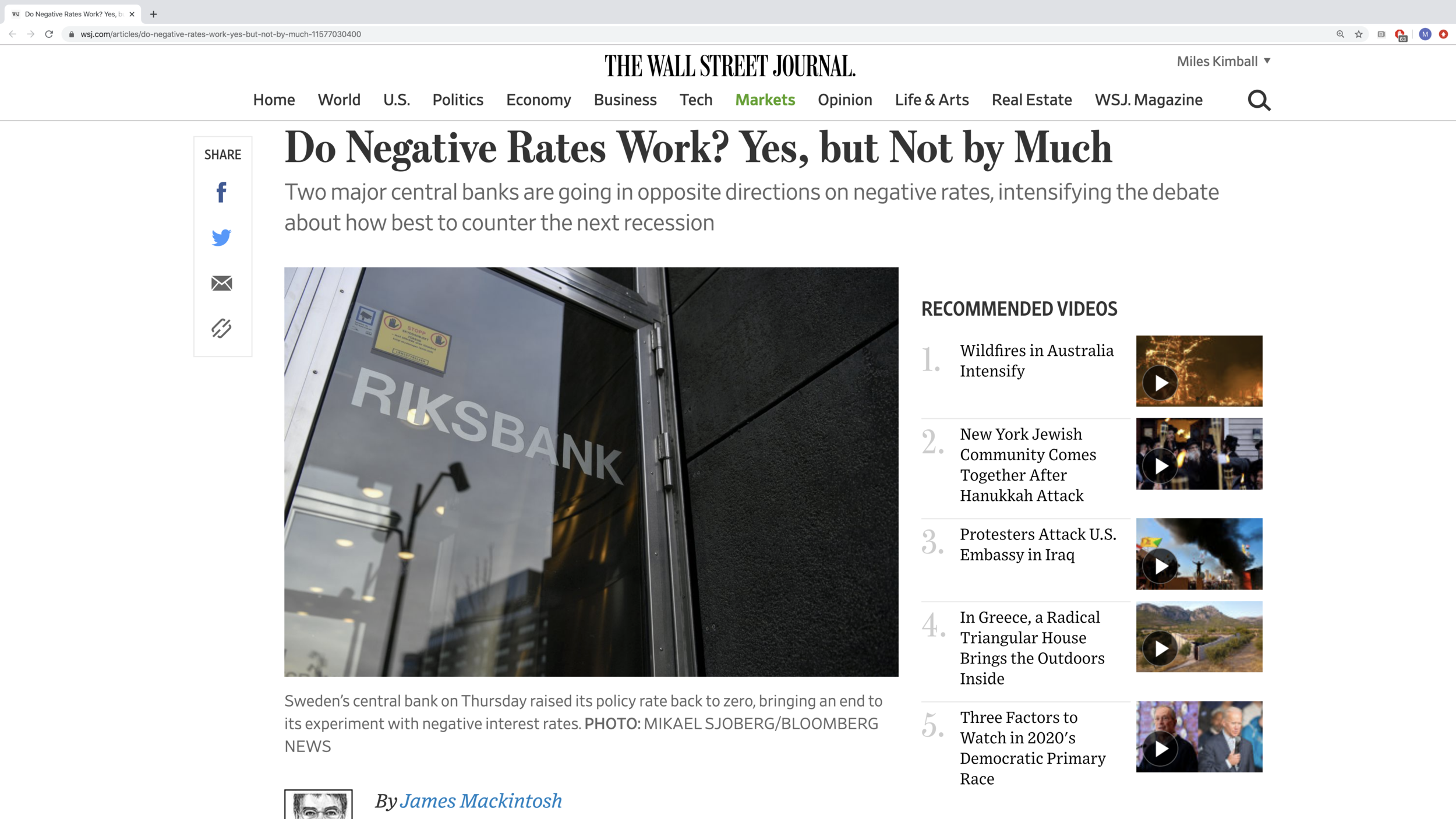The ECB’s Monetary Policy at 20—Massimo Rostagno, Carlo Altavilla, Giacomo Carboni, Wolfgang Lemke, Roberto Motto, Arthur Saint Guilhem and Jonathan Yiangou Defend Negative Rate Policy
The Central Bank of Sweden, the Riskbank, may be raising its rates prematurely because of an overeagerness to exit negative rates. But key players within the European Central Bank have reaffirmed their belief in the virtues of negative rates in a new European Central Bank Working Paper. The Riksbank’s explanation was scant, but the ECB Working Paper “A Tale of two decades: the ECB’s monetary policy at 20” great detail about the authors’ thinking.
In this post, I’ll only give Wall Street Journal author James Mackintosh’s comments on the ECB Working Paper. Here is his precis of the working paper:
… a group of the most senior monetary-policy staff at the European Central Bank published a long-awaited paper robustly defending negative rates. The eye-catching claim: The benefits for the economy would still outweigh the damage even if rates went twice as negative, to minus 1%.
…
The ECB paper led by Massimo Rostagno, head of the bank’s monetary policy division, insists that negative rates, alongside bond buying, forward guidance and cheap long-term loans to banks, provide multiple benefits.
First, it argues, demonstrating that there is no zero lower bound to rates takes away the fear that central banks are powerless to act when rates hit zero.
Second, negative rates—a charge on commercial bank deposits at the central bank—create a “hot potato” effect. Banks are encouraged to lend out or invest their money to avoid paying the ECB to hold their spare reserves. The banking system as a whole can’t escape the cost of negative rates, since the reserves have to end up back at the ECB in the end. But any individual bank with spare money can hope that if it is used to buy bonds or lent out, the recipient will pay it into an account at a rival, which will then have to take the hit from the ECB.
Third, the research found that cuts to rates when they are negative lower government bond yields more than cuts when they are positive. The biggest effect is on five-year bonds, which heavily affect fixed-rate lending. The explanation is tricky; one possibility that rather undermines the case for negative rates is that investors think things must be really bad for the central bank to try out even deeper negative rates, so expect rates to stay low for a long time. It’s easy for a central bank to cut rates in normal times, so they are usually expected to rebound toward a higher steady state within a few years.
Fourth, the negative rates helped other policies, such as forward guidance and corporate bond purchases, be more effective.
Finally, a model used in the study concludes that banks have made more money with negative rates than they would have if rates hadn’t been cut, and will continue to do so. This seemingly counterintuitive conclusion results because the squeeze on bank margins has been more than offset by rising fees, capital gains and lower provisions for losses than would have been the case.
James Mackintosh also gives a useful list of side effects emphasized by negative rate skeptics. With my numbering added, they are, in his words:
Bank margins are squeezed if they can’t pass on the negative rates to their own depositors;
pension funds and insurers forced by regulators to hold negative-yielding government bonds will find it hard to meet promises to customers; and
the prospect of better-than-free money may encourage financial and housing bubbles.
Let me react to each of these issues.
1. Squeezed bank margins
Squeezed bank margins can be avoided by having the central bank subsidize commercial banks for providing zero rather than negative rates to small household depositors and encouraging them to pass on negative rates commercial and large household depositors. See:
Ben Bernanke: Negative Interest Rates are Better than a Higher Inflation Target
Ruchir Agarwal and Miles Kimball—Enabling Deep Negative Rates to Fight Recessions: A Guide
Other mechanisms for subsidizing banks are also available. For example the ECB loans funds to commercial banks at below-market rates.
2. Low rates for pension funds
Here the problem is the use of mild negative rates for long periods of time rather than deep negative rates for short periods of time. (Of course, this requires modifications to paper currency policy. See “How and Why to Eliminate the Zero Lower Bound: A Reader’s Guide.”) Getting back to robust economic growth quickly with deep negative rates then makes it appropriate for a central bank to raise interest rates quickly as the economy recovers.
Note however that even if a central bank quickly returns an economy to the natural level of output and the long-run natural interest rate, that long-run natural interest rate might be lower than pension funds are used to in past decades. This is beyond a central bank’s control and must be addressed by supply-side policies. See:
3. Financial stability concerns
One of the best methods of combatting financial instability coming from house prices is to allow more residential construction—especially residential construction in desirable cities to live and work in. But this policy is beyond the purview of central banks. Most central banks do, however, have a hand in setting capital (equity) requirements, or at least have an influence on those who do. It is my contention that high enough capital requirements can dramatically reduce dangers from financial instability. That is not to say that interest rate policy should pay no attention to financial instability: rates should be raised when risk premia become unusually small and lowered when risk premia become unusually large. See:
Conclusion
I have met several of the authors of the new ECB Working Paper and found them very impressive. Their paper deserves a closer look.
For annotated links to other posts on negative interest rate policy, see:
